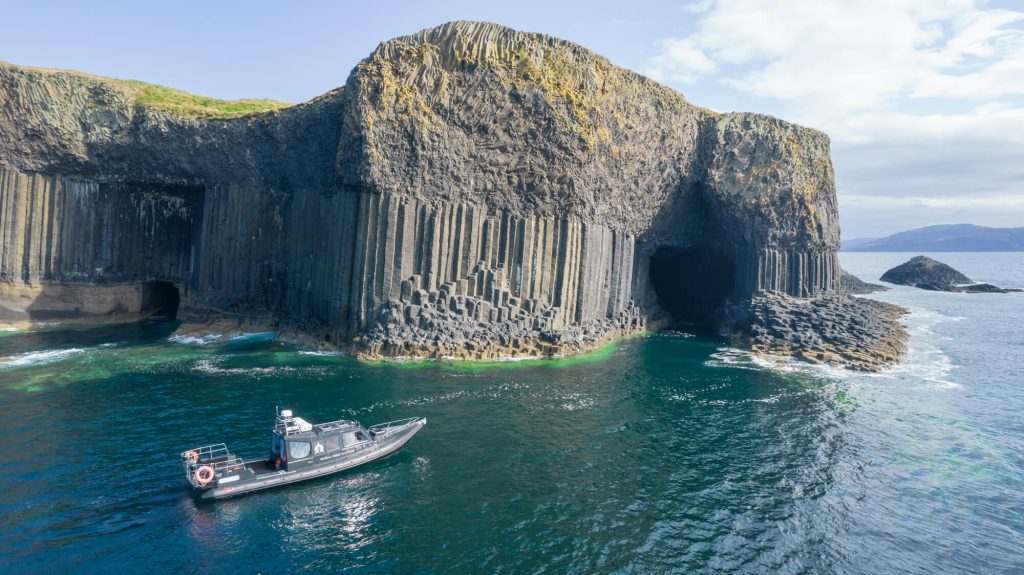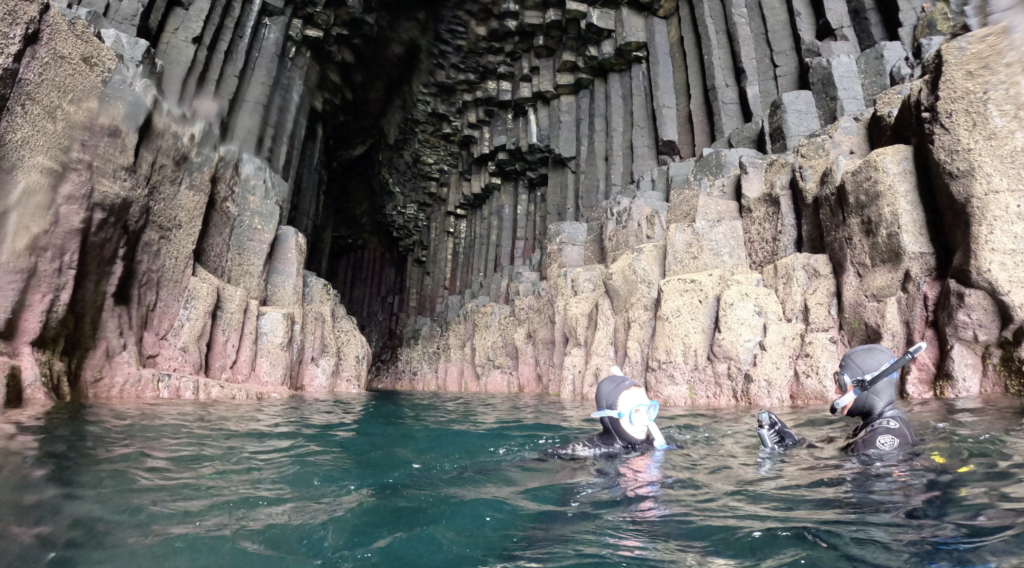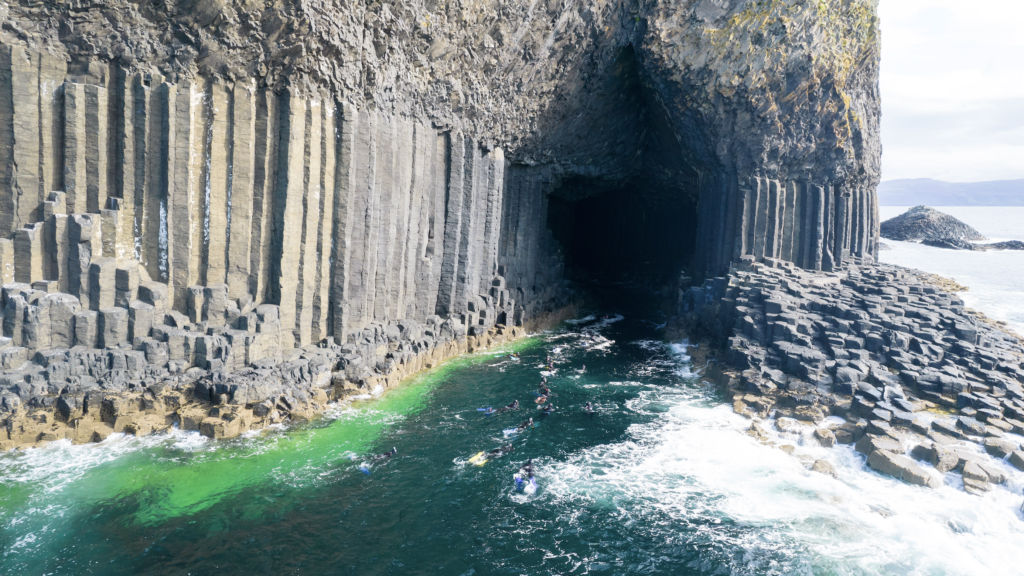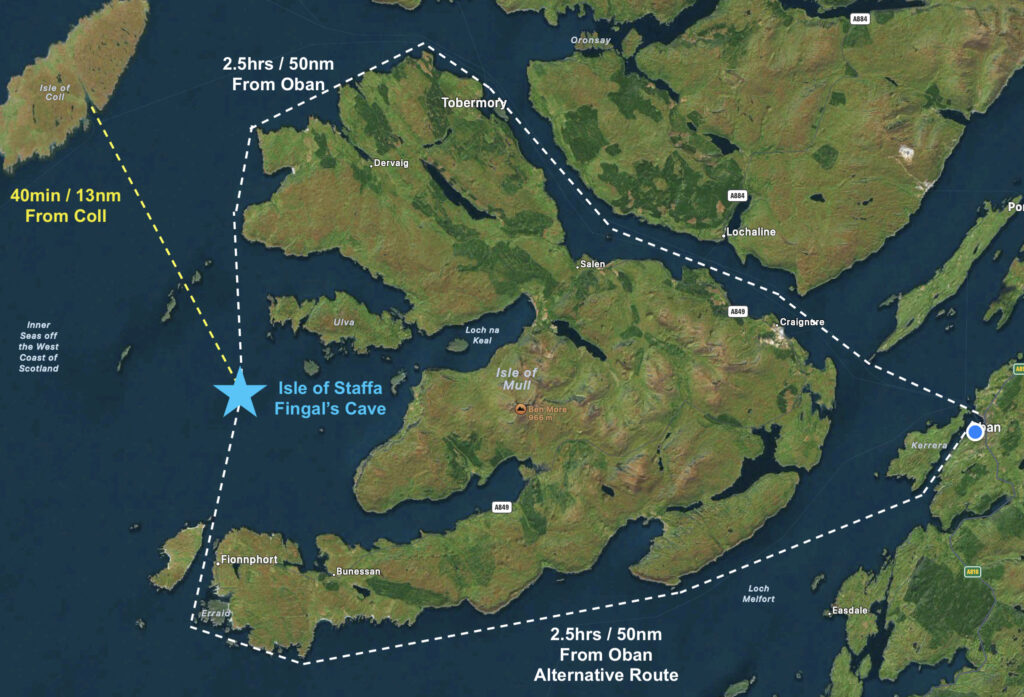
Can you swim in Fingal’s Cave
May 01 2024
Fingal’s Cave is a large sea cave on the south east side of the Isle of Staffa, which itself is located around 5 nautical miles off the west side of the Isle of Mull. Fingal’s Cave is an amazing place to swim but it is very exposed to the Atlantic swell & waves along with a lot of boat traffic during summer. Yes you can swim in Fingal’s cave, but we don’t advise doing it from the island itself and only with a specialist boat operator as safety cover.
Staffa & Fingal’s Cave Geology
The island of Staffa is very unique with it being covered in basalt columns and volcanic formations. The cave is around 20m high and 75m long. The island was formed from the Mull supervolcano around 59 million years ago. It may seem a long time ago now, and not that long after the dinosaurs went extinct. However these rocks are very young compared to the islands of Coll and Tiree only lying 12 miles to the west. These rocks which form part of the Lewisian gneiss complex sit at around 3 billion years old and are actually some of the oldest rocks known to humans! The ‘young’ columns of rock at Staffa which tower above you as you look into the cave were not man made. They were formed during the cooling process and the layers you see on the great face are different types of rock – a fascinating spectacle to look at.
Famous Visitors to Fingal’s Cave
Staffa and the cave gained popularity after a number of notable visitors. Including the composer Felix Mendelssohn who gained inspiration from his visit to create the Hebrides Overture. Others include Queen Victoria & James Boswell & Samuel Johnson. It’s now visited by nearly 100,000 people every year. However only a few hardy folk aim to tackle the swim!
Legends of Fingal’s Cave
There’s lots of myths and legends about Fingal’s Cave. The famous story is about Fingal the giant who visited his rival over in Northern Ireland who lived at the Giant’s Causeway. It’s said at that time the rocky causeway stretched all the way between the two places. Fingal headed over to battle with his rival Finn MacCool but his clever wife dressed him up as a baby to try and avoid the conflict. When Fingal saw the size of the baby eating rocks, he decided battling the father was a bad idea. He fled back to Staffa and tore up the causeway between the two lands.
Other legends warn unsuspecting sailors travelling past that Fingal preys upon them and once captured, hangs them in glass bottles at the back of the cave. Also that there are magical creatures that live in the waters in the cave. So would be swimmers enter at their own risk! We were lucky enough to see a mermaid once, believe it or not!
Swimming Fingal’s Cave
So, onto swimming at the cave. It’s a wonderful experience to swim into Fingal’s Cave, seeing the columns tower above your head. Below the waves, dense kelp forest covers the rock eventually leading to the pebble seabed. Further into the cave, the rock walls are covered in all sorts of sponge, anemones and corals. It’s a big bucket list item for many of our trips however as much as that all sounds lovely, it can also be a very dangerous place.
Dangers & Safety Considerations of Swimming at Fingal’s Cave
Fingal’s Cave location faces the open Atlantic and there is no land due west of the cave till you get to Canada! Our prevailing wind and swell comes from the west/south west so it can be very rough with large swells and waves. Of course in these conditions it’s easy to decide that it’s dangerous to swim. Most of the problems actually come during calm conditions when it looks very inviting. Staffa is a very popular place to visit with tourist boats from Mull and we do see some people jumping in from the rocks and have to offer them some ‘friendly’ advice or even rescue some of them.
- Swell
The swell rolls in from the Atlantis and even on a calm day can funnel into the cave out of nowhere. Just like a waves break on shore, the swell reaches the shallower water and pushes into the cave rising quickly up ad down the walls of the cave. It can be very hard to swim against and also has the risk of throwing you against the rocks. It’s easy to jump in but the main point is to figure out how to exit thew water.
- Currents
The currents can be very strong around the islands with the largest tidal range over 4m. Currents are a big consideration when swimming. The current can flow along the entrance outside the cave again making it a challenging swim. Generally this is fine with the boat nearby to pick you up, but to go from shore you risk getting pulled away from the shore and being unable to get back.
- Barnacles
The rocks that are exposed at lower tides are completely covered in barnacles. We advise people to stay away from them as they can easily shred a wetsuit. However this is the place that most people would look to enter or exit from the shore. It’s very rare that there is very still water so entry from the rocks risks you getting dragged along them. If the waves wash you against them, then you can get badly grazed, so we always wear advise wetsuits for warmth’s buoyancy and protection even from the boat.
- Jellyfish
For the same reason the cave focusses the incoming swell, it also catches a lot of jellyfish that can’t escape. It has led to some stunning photography from our guests, but another reason we recommend full wetsuits, hood, gloves and boots. It can be jellyfish soup in the cave including some of the stinging variety. However being covered in neoprene means you aren’t touched by the tentacles and using a mask and snorkel lets you see them in the water, observe, admin and avoid them!
- Boat traffic
Apart from sea conditions, boat traffic is the biggest hazard at Fingal’s Cave. There are a number of large tourist boats that visit from Mull who take the boats into the mouth of the cave. This is in addition to visiting cruise boats, yachts, speedboats and dingys. These boats don’t always see people swimming from the rocks and has led to a number of near misses. We try to avoid the busier times and keep our boat nearby, along with flying the a-flag and radio any vessels that turn up.
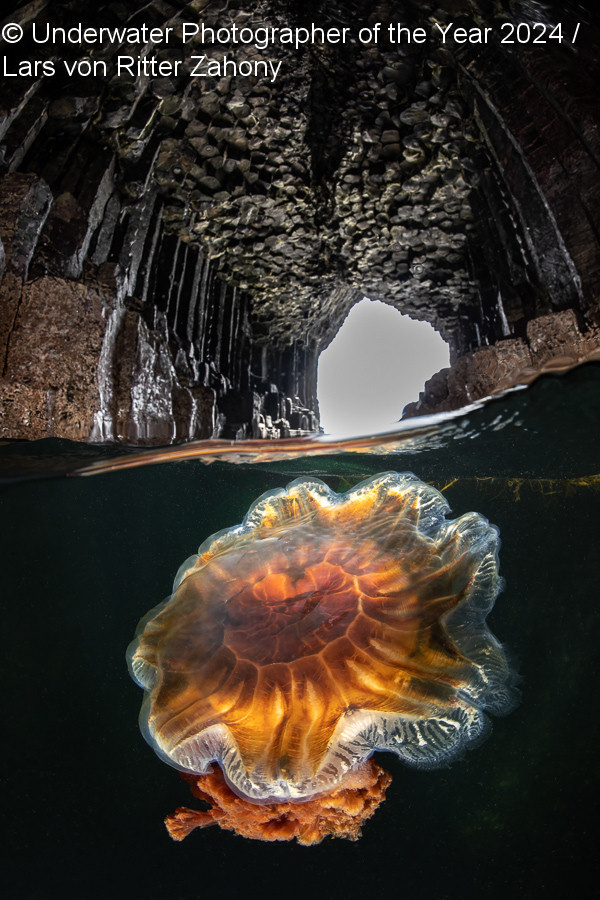
Swimming Fingal’s Cave With Basking Shark Scotland
Our trips out to swim the cave are adventurous but we are also very safety conscious. Usually we visit during our multi-day tours where we can pick the best conditions to visit at an optimal time when it’s quiet of boats. You will have also had some time to gain some experience in the water to practice before heading out there. It’s not the place to turn up unprepared and jump in straight away. The more prepared you are, the better you will enjoy it.
We do run single day trips for private bookings from Oban or Mull, it’s hard to get the weather for this so there is some risk that conditions aren’t calm enough when we reach the cave. If you have some luck with calm conditions, we have a practice swim first which includes the techniques for being dropped off from the boat and then re-boarding on the ladder along with getting used to snorkel gear. Our guide will give you should advice on best techniques.
On all of our trips, our guide will accompany you into the cave as a safety swimmer along with guiding you through all the formations and marine life to discover. Back on board our skipper will be hovering close by as a safety boat, watching out for other boat traffic. If you get tired or have a problem we can recover you quickly. On board we have first aid and oxygen just in case and we’re all trained in rescue & first aid. We’re insured for all our activities and have invested a lot into being able to offer these experiences with experienced crew.
The other benefit of swimming the cave with us is that we don’t just visit Fingal’s Cave. We often visit Boat & MacKinnons caves nearby too, these are vastly different with amazing underwater formations and even a hidden passage through the island that we can only do during very specific conditions & tide. Here’s a sneak peek of what it’s like swimming in boat cave!
Wild Swimming Fingal’s Cave
Although we take wild swimming groups, we do recommend using snorkeling equipment with fins to aid propulsion. Swimming in and out can be tiring so tow floats are mandatory for these groups using thin swimming wetsuits and no fins. We can swim in rougher conditions using snorkeling equipment more than you can with just swimming, but snorkeling does take some practice. So this is why we recommend longer tours or even completing a snorkel course with us. Please talk with us about your aspirations and we’ll be able to advise what the best situation is.
Where is Fingal’s Cave and how to get there?
The main places we visit Fingal’s cave is from Oban or Coll depending on the time of year. Travelling from Oban is a long journey, around 50 nautical miles (93km) and 2.5hours one way direct. We can pick up groups from Tobermory or near Fionnphort for a shorter sea journey as an option (but we still have to go from Oban!). The other option is that we offer the swim as part of our three, four and seven day tours from Coll. It’s approx 13miles or 40min away and with a number of days we try and pick the best window to visit. However during periods of swell, conditions can be too rough for as long as a week.
It may seems a long way but the journey has lots of wildlife watching opportunities and spectacular scenery along the way. We can make bespoke itineraries to add in wild swim dip in beautiful lagoons and bays, combine a landing tour to visit the puffins or visit Iona too.
Here are the main opportunities to swim Fingal’s Cave with us
- One Day Private Charter From Oban, Tobermory, Fionnphort or Coll
- 5 Day Spring Tour From Oban
- 4 Day Autumn Tour From Oban
- Three / Four & Seven Day Tour From Coll


